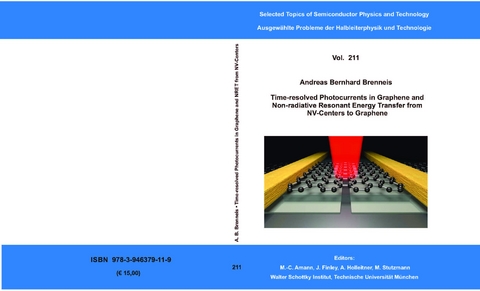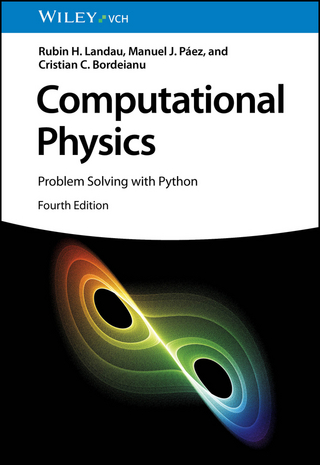
Time-resolved Photocurrents in Graphene and Non-radiative Resonant Energy Transfer from NV-Centers to Graphene
Seiten
2017
Verein zur Förderung des Walter Schottky Instituts der Technischen Universität München (Verlag)
978-3-946379-11-9 (ISBN)
Verein zur Förderung des Walter Schottky Instituts der Technischen Universität München (Verlag)
978-3-946379-11-9 (ISBN)
- Keine Verlagsinformationen verfügbar
- Artikel merken
In this thesis, we integrate graphene based devices into THz stripline circuits to analyze the ultrafast photocurrent dynamics with an unique on-chip photocurrent spectroscopy technique. For this purpose, we excite the graphene based devices with a focused, pulsed laser source and examine the subsequent photocurrent dynamics. The temporal resolution of this experimental approach is approximately one picosecond. Furthermore, the characteristics of the photocurrent are analyzed in terms of its dependence on the excitation position, the excitation power and the bias voltage of the device. We assign the relaxation dynamics to different decay channels, that dissipate the energy from the optically induced, electronic excitation, i.e. optical phonon scattering, supercollision scattering, and surface polar phonon scattering. Regarding the underlying photocurrent mechanisms we distinguish two main effects. (i) The photovoltaic effect manifests itself as a displacement current that occurs immediately after the pulsed optical excitation. It lasts for an ultrashort period of about 1.4 ps. This current shows a saturable absorption effect for excitation intensities of approximately 0.17 GW cm−2 , which is caused by Pauli blocking. (ii) The timescale of the thermoelectric effect depends on the thermal coupling of the graphene to the substrate. On the one hand, sufficient coupling can result in a decay within a few picoseconds by theabove mentioned phononic scattering mechanisms. On the other hand, we observe thermoelectric currents, which last a few hundreds of picoseconds, if the graphene is supported by metal contacts. This timescale can be understood from the heat reservoir of the metal striplines. Furthermore, an applied electric field can cause additional photocurrents, which show a similar timescale as the thermoelectric currents. This is in accordance with a charge carrier mobility that is increased as long as the temperature of the electron bath is elevated.
While the hot charge carriers relax, the electron bath is out of equilibrium with respect to the lattice temperature. This phenomenon emerges because the decay dynamics of the electron bath to the phonon bath happen on a much longer timescale than the pulsed optical excitation and the subsequent thermalization of the electron bath. The latter is mainly caused by the electron-electron scattering in graphene.
In addition, we investigate the thermoelectric effect in dependence of graphene’s charge carrier density. To this end, we implement two adjacent back-gates as a new functional part into the THz-stripline circuitry underneath the graphene sheet. We describe an immediate photo-thermoelectric current of the unbiased device following a femtosecond laser excitation. For a picosecond timescale after the optical excitation, an additional photo-thermoelectric contribution shows up, which exhibits the fingerprint of a spatially inverted temperature profile. The latter can be understood by the different time-constants and thermal coupling mechanisms of the electron and phonon baths within graphene to the substrate and the metal contacts. The interplay of the processes gives rise to ultrafast electromagnetic transients in high-frequency circuits, and it is equally important for a fundamental understanding of graphene-based ultrafast photodetectors and switches.
Furthermore, we study the coupling of graphene to nitrogen vacancy (NV) centers. The resulting ultrafast charge carrier dynamics stem from directly excited charge carriers in the graphene and additionally, from excitations, which are transferred from the nitrogen vacancy centers. Such non-radiative energy transfer processes are often regarded as loss channels for an optical emitter because they are inherently difficult to be accessed experimentally. So far, the energy of the transferred electronic excitations has been considered to be lost within the electron bath of the graphene. In this thesis, we demonstrate that the transferred excitations can be read out by detecting corresponding currents with a picosecond time resolution. Beyond that, we detect electronically the spin of nitrogen-vacancy centers in diamond and control the non-radiative transfer to graphene by electron spin resonance. Our results open the avenue for incorporating nitrogen-vacancy centers into ultrafast electronic circuits and for harvesting non-radiative transfer processes electronically.
While the hot charge carriers relax, the electron bath is out of equilibrium with respect to the lattice temperature. This phenomenon emerges because the decay dynamics of the electron bath to the phonon bath happen on a much longer timescale than the pulsed optical excitation and the subsequent thermalization of the electron bath. The latter is mainly caused by the electron-electron scattering in graphene.
In addition, we investigate the thermoelectric effect in dependence of graphene’s charge carrier density. To this end, we implement two adjacent back-gates as a new functional part into the THz-stripline circuitry underneath the graphene sheet. We describe an immediate photo-thermoelectric current of the unbiased device following a femtosecond laser excitation. For a picosecond timescale after the optical excitation, an additional photo-thermoelectric contribution shows up, which exhibits the fingerprint of a spatially inverted temperature profile. The latter can be understood by the different time-constants and thermal coupling mechanisms of the electron and phonon baths within graphene to the substrate and the metal contacts. The interplay of the processes gives rise to ultrafast electromagnetic transients in high-frequency circuits, and it is equally important for a fundamental understanding of graphene-based ultrafast photodetectors and switches.
Furthermore, we study the coupling of graphene to nitrogen vacancy (NV) centers. The resulting ultrafast charge carrier dynamics stem from directly excited charge carriers in the graphene and additionally, from excitations, which are transferred from the nitrogen vacancy centers. Such non-radiative energy transfer processes are often regarded as loss channels for an optical emitter because they are inherently difficult to be accessed experimentally. So far, the energy of the transferred electronic excitations has been considered to be lost within the electron bath of the graphene. In this thesis, we demonstrate that the transferred excitations can be read out by detecting corresponding currents with a picosecond time resolution. Beyond that, we detect electronically the spin of nitrogen-vacancy centers in diamond and control the non-radiative transfer to graphene by electron spin resonance. Our results open the avenue for incorporating nitrogen-vacancy centers into ultrafast electronic circuits and for harvesting non-radiative transfer processes electronically.
| Erscheinungsdatum | 14.03.2018 |
|---|---|
| Sprache | englisch |
| Maße | 150 x 210 mm |
| Themenwelt | Naturwissenschaften ► Physik / Astronomie |
| Schlagworte | • Non-radiative energy transfer between nitrogen vacancy centers in diamond and graphene • • Thermoelectric non-equilibrium dynamics and currents • time-resolved photocurrents • • Ultrafast photocurrents in Graphene |
| ISBN-10 | 3-946379-11-7 / 3946379117 |
| ISBN-13 | 978-3-946379-11-9 / 9783946379119 |
| Zustand | Neuware |
| Haben Sie eine Frage zum Produkt? |
Mehr entdecken
aus dem Bereich
aus dem Bereich
von den Werkzeugen über Methoden zum TQM
Buch | Softcover (2024)
Springer Fachmedien (Verlag)
32,99 €
Problem Solving with Python
Buch | Softcover (2024)
Wiley-VCH (Verlag)
109,00 €


